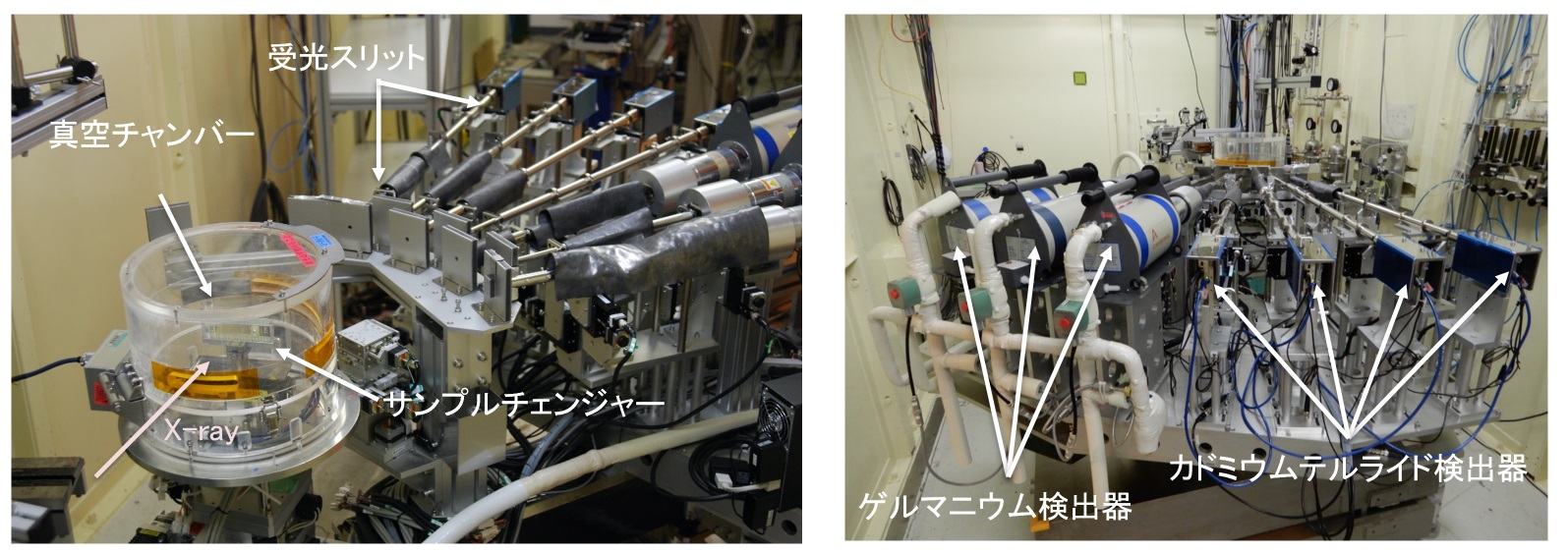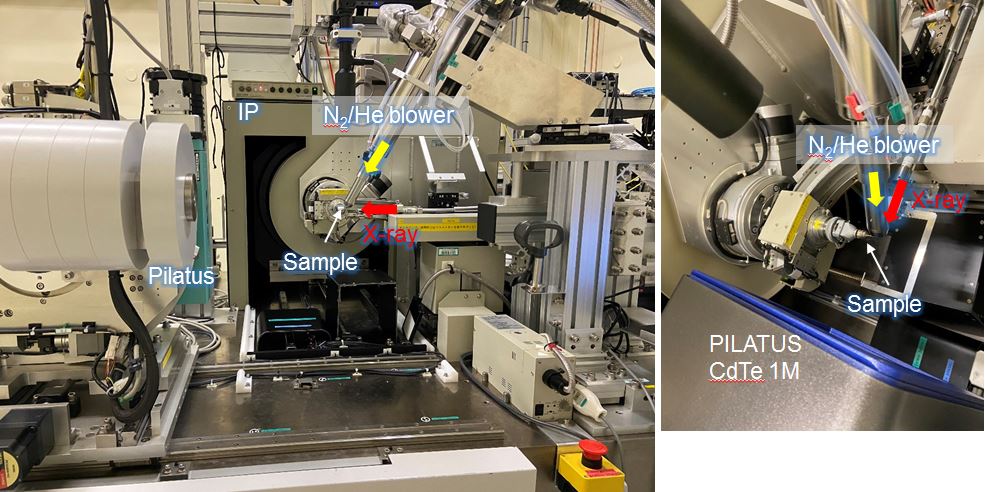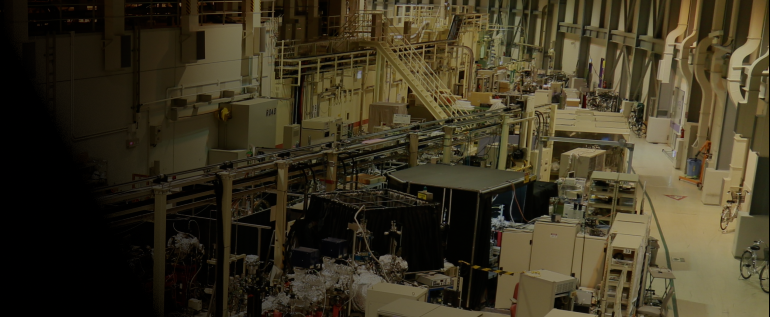- 詳細
- 投稿者: Super User
- カテゴリ: 設備
- 参照数: 708
検出器7連装PDF解析装置
◆装置概要
液体や非晶質物質の精密なPDF構造解析を行うことができます。CO2レーザーとガス浮遊を組み合わせた超高温計測や、高エネルギーX線を利用した非破壊内部分析にも対応しています。

◆装置の特徴
水平二軸回折計θ、2θの水平振り2軸回折計であり、バックグラウンドを低減させるためにポイント型検出器の前に受光ダブルスリットを搭載しています。広いQ範囲のデータから高い実空間分解能のPDF解析データを取得することが可能です。(Qmax<30Å-1)
検出器
高エネルギー対応のCdTe半導体検出器4台とGe半導体検出器3台を採用しています。8度間隔で配置し、短時間で広いQ空間のデータを収集することが可能です。
CdTe半導体検出器(搭載モデル:X-123CdTe)の詳しい仕様はこちらから。(https://www.amptek.com/products/sdd-x-ray-detectors-for-xrf-eds/x-123sdd-complete-x-ray-spectrometer-with-silicon-drift-detector-sdd)
Ge半導体検出器(搭載モデル:GL0515)の詳しい仕様はこちらから。(http://www.gammadata.se/assets/Uploads/LEGe-SS-C49322.pdf)
制御ソフトウェア
JASRIにて製作したGUI中心の制御となっています。詳しい仕様はこちらから。(http://rud.spring8.or.jp/member/0020758/BL04B2_control_ver0.pdf)
◆装置アクセサリー
高温電気炉(リガク製、室温〜1,100℃)
ガス浮遊炉(800〜3,000℃)
窒素吹きかけ式低温装置(オックスフォード製:Cryojet5、-196℃〜室温)
クライオスタット(リガク製、-243℃〜室温)
◆実験・試料準備
試料容器としては、肉厚の薄いX線回折試料用キャピラリーがお勧めです(例えば、オーバーシーズ・エックスレイ・サービス製:http://www.oxs.co.jp)。内径2~3mm程度のサイズのものがよく使われます。
また、室温実験の場合、バックグラウンドを抑えたポリイミドチューブ(K-NEX製:http://www.kei-nex.com/process.html#pageLink01)も使われます。
試料をキャピラリーに充填し封止されて持ち込まれる場合、10-2Pa程度の真空度でリークチェックを事前にお願いします。
◆実験手順・注意事項
1.試料を二軸回折計のステージの上にマウントします。
2.実験ハッチから退出します。
3.ビームシャッターを制御ソフトウェアから開き、X線をサンプルへ照射します。そして、2θ軸を0.3°〜9°まで0.1°おきに200msecずつのクイック測定を行い、全散乱データを確認します。
4.散乱強度の一番強い2θの位置を探し、X方向(X線と直行する方向をXとしています)のスキャンを±2mmの範囲で行い、強度が最大となるXの値に調整します。
5.続いて、Z方向のスキャンを±1mmの範囲で行い、強度が最大となるZの値に調整します。
6.2θ軸を45°へ移動し、Y方向(X線の進行方向をYとしています)のスキャンを±3mmの範囲で行い、強度が最大となるYの値に調整します。
7.サンプルの位置出しが終了したら、本測定を開始します。測定は、2θが0.3°〜9°で、液体や非晶質物質は0.1°おきに1点あたり10sec程度、結晶物質は0.02°おきに1点あたり2sec程度の測定を行います。
8.7の測定を十分な統計精度が得られるまで繰り返します。
◆問い合わせ先
尾原 幸治(このメールアドレスはスパムボットから保護されています。閲覧するにはJavaScriptを有効にする必要があります。)
河口 沙織(このメールアドレスはスパムボットから保護されています。閲覧するにはJavaScriptを有効にする必要があります。)
山田 大貴(このメールアドレスはスパムボットから保護されています。閲覧するにはJavaScriptを有効にする必要があります。)
◆代表的な論文リスト
"Noncrystalline Nanocomposites as a Remedy for the Low Diffusivity of Multivalent Ions in Battery Cathodes"
Yuki Orikasa, Kazuaki Kisu, Etsuro Iwama, Wako Naoi, Yusuke Yamaguchi, Yoshitomo Yamaguchi, Naohisa Okita, Koji Ohara, Toshiyuki Munesada, Masashi Hattori, Kentaro Yamamoto, Patrick Rozier, Patrice Simon, and Katsuhiko Naoi
Chemistry of Materials, 32, (2020) 1011-1021
DOI : 10.1021/acs.chemmater.9b03665
"Lithium-ion Coordination-Induced Conformational Change of PEG Chains in Ionic-Liquid-Based Electrolytes"
Yuji Kamiyama, Masayuki Shibata, Ryo Kanzaki, and Kenta Fujii
Physical Chemistry Chemical Physics, 22, (2020) 5561-5567
DOI : 10.1039/c9cp06717e
"Structure and Negative Thermal Expansion in Zr0.3Sc1.7Mo2.7V0.3O12"
Huanli Yuan, Chunyan Wang, Qilong Gao, Xianghong Ge, Hao Sun, Saul H. Lapidus, Juan Guo, Mingju Chao, Yu Jia, and ErJun Liang
Inorganic Chemistry, 59, (2020) 4090-4095
DOI : 10.1021/acs.inorgchem.0c00126
"Very Sharp Diffraction Peak in Nonglass-Forming Liquid with the Formation of Distorted Tetraclusters"
Chihiro Koyama, Shuta Tahara, Shinji Kohara, Yohei Onodera, Didrik R. Småbråten, Sverre M. Selbach, Jaakko Akola, Takehiko Ishikawa, Atsunobu Masuno, Akitoshi Mizuno, Junpei T. Okada, Yuki Watanabe, Yui Nakata, Koji Ohara, Haruka Tamaru, Hirohisa Oda, Ippei Obayashi, Yasuyuki Hiraoka, and Osami Sakata
NPG Asia Materials, 12, (2020) 43
DOI : 10.1038/s41427-020-0220-0
"Synthesis, Electrochemical Properties, and Changes in Crystal and Electronic Structures during Charge/Discharge Process of Spinel-Type Cathod Materials Mg4V5-xNixO12 (x = 0, 0.3, 0.6, 1.0) for Magnesium Secondary Batteries"
Yasushi Idemoto, Natsumi Kawakami, Naoya Ishida, and Naoto Kitamura
Journal of Power Sources, 455, (2020) 227962
DOI : 10.1016/j.jpowsour.2020.227962
PDF Analysis Equipment with 7-Fold Multiple Detector
◆Equipment overview
Precise PDF structural analysis can be performed on liquid and amorphous substances. By combining a CO2 laser and floating gas, ultra-high temperature measurements can be taken, and by using high-energy X-rays, non-destructive internal analysis can be completed.

◆Features of the Equipment
Horizontal Biaxial DiffractometerA θ and 2θ axis horizontal swing diffractometer is equipped before the double-slit point-type detector, and exists to decrease the background. It is possible to obtain high real-space resolution PDF analysis data from a wide Q range of data.(Qmax<30A-1)
Detector
Four high-energy CdTe semiconductor detectors, and three Ge semiconductor detectors are used. By using intervals of 8 degrees, it is possible to collect wide Q space data in a very short time.
Click here for detailed specifications of the CdTe semiconductor detector (Equipped Model: X-123CdTe).
(https://www.amptek.com/products/sdd-x-ray-detectors-for-xrf-eds/x-123sdd-complete-x-ray-spectrometer-with-silicon-drift-detector-sdd)
Click here for detailed specifications of the Ge semiconductor detector (Equipped Model: GL0515).
(http://www.gammadata.se/assets/Uploads/LEGe-SS-C49322.pdf)
Control Software
This software is controlled by a GUI and was created by JASRI. Please click here for detailed specifications. (http://rud.spring8.or.jp/member/0020758/BL04B2_control_ver0.pdf)
◆Equipment accessories
High Temperature Electric Furnace (Manufactured by Rigaku: room temperature to 1,100℃)
Gas Suspension Furnace (800℃ to 3,000℃)
Low Temperature Nitrogen Spraying Device (Manufactured by Oxford: Cryojet 5, -196℃ to Room Temperature)
Cryostat (Manufactured by Rigaku: -243℃ to Room Temperature)
◆Experiment / sample preparation
It is recommended that a thin X-ray diffraction sample capillary is used for a sample container (One example is manufactured by Overseas X-Ray Service: http://www.oxs.co.jp ). Sizes with inner diameter between 2-3mm are often used.
Also, for room temperature experiments, a background suppressing polyimide tube is also used (manufactured by K-NEX: http://www.kei-nex.com/process.html#pageLink01).
After filling the capillary with the sample and sealing, in advance to bringing the sample to the experiment, please perform a vacuum leak test to an approximate degree of 10-2Pa.
◆Experimental procedure / precautions
1. Mount the sample on top of the biaxial diffractometer stage.
2. Exit the experiment hatch.
3. Open the beam shutter from the control software and irradiate the sample with X-rays. Then, on the 2θ-axis measurements can be taken 0.1°every 200msec between 0.3°- 9°, and the total scattering data can be verified.
4. Find the position of 2θ with the strongest scattering intensity, then scan the X-direction (The direction the X-rays are travelling is X) in a ±2mm range, finally, adjust to the value of X with the maximum intensity.
5. Similarly, scan the Z-direction with a range of ±1mm to find the maximum intensity, then adjust the value of Z.
6. Move the 2θ axis to 45°, then scan in the Y direction (The direction of the X-ray is the Y direction) with a range of ±3mm for the maximum intensity, then adjust the value of Y.。
7. When the sample is properly positioned, begin the measurement. The measurement is made with 2θ between 0.3° - 9° for liquids and amorphous substances, with each point being 0.1°every 10 seconds. For crystalline substances, each point is measured with 0.02° every 2 seconds.。
8. Repeat the measurement 7 times, or until sufficient statistical accuracy is obtained.
◆Contact
尾原 幸治(このメールアドレスはスパムボットから保護されています。閲覧するにはJavaScriptを有効にする必要があります。)
河口 沙織(このメールアドレスはスパムボットから保護されています。閲覧するにはJavaScriptを有効にする必要があります。)
山田 大貴(このメールアドレスはスパムボットから保護されています。閲覧するにはJavaScriptを有効にする必要があります。)
◆List of representative treatises
"Noncrystalline Nanocomposites as a Remedy for the Low Diffusivity of Multivalent Ions in Battery Cathodes"
Yuki Orikasa, Kazuaki Kisu, Etsuro Iwama, Wako Naoi, Yusuke Yamaguchi, Yoshitomo Yamaguchi, Naohisa Okita, Koji Ohara, Toshiyuki Munesada, Masashi Hattori, Kentaro Yamamoto, Patrick Rozier, Patrice Simon, and Katsuhiko Naoi
Chemistry of Materials, 32, (2020) 1011-1021
DOI : 10.1021/acs.chemmater.9b03665
"Lithium-ion Coordination-Induced Conformational Change of PEG Chains in Ionic-Liquid-Based Electrolytes"
Yuji Kamiyama, Masayuki Shibata, Ryo Kanzaki, and Kenta Fujii
Physical Chemistry Chemical Physics, 22, (2020) 5561-5567
DOI : 10.1039/c9cp06717e
"Structure and Negative Thermal Expansion in Zr0.3Sc1.7Mo2.7V0.3O12"
Huanli Yuan, Chunyan Wang, Qilong Gao, Xianghong Ge, Hao Sun, Saul H. Lapidus, Juan Guo, Mingju Chao, Yu Jia, and ErJun Liang
Inorganic Chemistry, 59, (2020) 4090-4095
DOI : 10.1021/acs.inorgchem.0c00126
"Very Sharp Diffraction Peak in Nonglass-Forming Liquid with the Formation of Distorted Tetraclusters"
Chihiro Koyama, Shuta Tahara, Shinji Kohara, Yohei Onodera, Didrik R. Smabraten, Sverre M. Selbach, Jaakko Akola, Takehiko Ishikawa, Atsunobu Masuno, Akitoshi Mizuno, Junpei T. Okada, Yuki Watanabe, Yui Nakata, Koji Ohara, Haruka Tamaru, Hirohisa Oda, Ippei Obayashi, Yasuyuki Hiraoka, and Osami Sakata
NPG Asia Materials, 12, (2020) 43
DOI : 10.1038/s41427-020-0220-0
"Synthesis, Electrochemical Properties, and Changes in Crystal and Electronic Structures during Charge/Discharge Process of Spinel-Type Cathod Materials Mg4V5-xNixO12 (x = 0, 0.3, 0.6, 1.0) for Magnesium Secondary Batteries"
Yasushi Idemoto, Natsumi Kawakami, Naoya Ishida, and Naoto Kitamura
Journal of Power Sources, 455, (2020) 227962
DOI : 10.1016/j.jpowsour.2020.227962
- 詳細
- 投稿者: Super User
- カテゴリ: 設備
- 参照数: 463
高エネルギーX線構造解析装置
◆装置概要
汎用的に有機、無機物質の高分解能構造解析を行うことができます。機能性材料の電子密度レベルの精密解析などに利用されています。
装置写真:高エネルギーX線対応の半導体検出器を用いた単結晶構造解析装置

◆装置の特徴
本装置は、汎用的に有機、無機物質の高分解能構造解析を行うことができます。機能性材料の電子密度レベルの精密解析などに利用されています。1/4χゴニオメータを搭載し、検出器として半導体検出器のPILATUS3 X CdTe 1M及び湾曲型のイメージングプレートを切り替えて使用することが可能です。・1/4χ回折計
ω、χ、φ軸の3軸を搭載した回折計であり、構造解析に必要とされる逆空間を網羅的に観測することが可能です。(IP: 2θmax < 145°; PILATUS: 2θmax < 65°)
・検出器
・高エネルギーX線対応半導体検出器
本検出器は、CdTeを検出素子として採用した高エネルギー対応の半導体検出器です。回折像の高速読み出しが可能であり、短時間で単結晶構造解析データを収集することが可能です。詳しい仕様はこちらから。
・大型湾曲IPカメラ
X線エネルギーの選択性がほとんどなく、広いダイナミックレンジを有し、大面積を一度に観測できる検出器です。主に、電子密度分布などの精密構造解析に使用されます。詳しい仕様はこちらから。
・制御ソフトウェア
実験室の装置でも使用されているリガク社製の制御ソフト「Control」を半導体・大型湾曲IPカメラで使用しており、実験室と同様の操作で回折データの収集が可能です。
◆装置アクセサリー
本システムでは、下記のアクセサリーの使用が可能です。
・ヘリウムガス吹付け低温装置(20〜400K)
・高温窒素ガス吹き付け装置(300〜800K)
・紫外線照射装置
・キセノン光源
・高圧電場印加装置
・X線パルスセレクター
◆実験・試料準備
測定の際に試料を取り付けるホルダは実験室系の装置で一般的に使用されるマイクロマウントやループ、またはガラス針を利用できる(ベースからの高さ20mm程度)。ゴニオメータヘッドにはマグネットやφ3mmの金属棒部分で保持することが可能です。空気中で溶媒脱離などにより結晶性が劣化する場合にはビームラインに設置された実体顕微鏡を利用してビームラインでの試料取り付けも可能です。
◆実験手順・注意事項
単結晶構造解析の実験は、実験室の装置とほぼ同様の手順で行えるようになっています。下記に一般的な単結晶構造解析実験の手順を示します。
1)試料を試料ホルダに取り付ける
試料ホルダは一般的に実験室系で利用されるマイクロマウント、ループ、ガラス針が利用できる。(ベースからの高さ20mm程度)
2)試料ホルダを回折計に取り付ける
3)センタリング
φ、ω軸に対してセンタリングを行います。
4)仮測定による結晶の評価
短時間(数分間)の測定を行って結晶性や回折強度をチェックします。
5)データ測定
チェック測定の結果を基にして露光時間やX線強度を決定してデータ測定を行う。 通常はφ:0,90,180,270°の各位置でω:0~180°の範囲をΔω<1°毎に回折像を取得する。PILATUSの読み取り時間が短いため、シャッターレス測定が行われ、1秒露光の場合約12分で全反射の測定が完了する。
6)回折強度の積分
ビームラインに導入されている積分用ソフトウェアを利用して回折像から回折強度を抽出する。 利用可能なソフト:Rapid Auto、CrysAlisPro(RIGAKU)、 APEX3(Bruker)
7)構造解析
積分処理によって得られた結晶学データおよび回折強度データから構造解析を行う。実験後に大学などで解析を進める場合も多く、実験者の使い慣れたソフトでの解析を行うため、原則として構造解析用のソフトウェアはユーザーが準備することを推奨している。
◆問い合わせ先
杉本邦久(このメールアドレスはスパムボットから保護されています。閲覧するにはJavaScriptを有効にする必要があります。)
安田伸広(このメールアドレスはスパムボットから保護されています。閲覧するにはJavaScriptを有効にする必要があります。)
中村唯我(このメールアドレスはスパムボットから保護されています。閲覧するにはJavaScriptを有効にする必要があります。)
◆代表的な論文リスト
"Observation of the Asphericity of 4f-electron Density and its Relation to the Magnetic Anisotropy Axis in Single-Molecule Magnets"
Gao Chen et al.
Nature Chemistry, 12, (2020) 213-219
DOI : 10.1038/s41557-019-0387-6
"X-ray Electron Density Investigation of Chemical Bonding in van der Waals Materials"
Kasai Hidetaka et al.
Nature Materials, 17, (2018) 249-252
DOI : 10.1038/s41563-017-0012-2
"A Linear Cobalt(II) Complex with Maximal Orbital Angular Momentum from a Non-Aufbau Ground State"
Bunting Philip C. et al.
Science, 362, (2018) eaat7319
DOI : 10.1126/science.aat7319
"Observation of Quadrupole Helix Chirality and its Domain Structure in DyFe3(BO3)4"
Usui T. et al.
Nature Materials, 13, (2014) 611-618
DOI : 10.1038/NMAT3942
"Electronic Nematicity above the Structural and Superconducting Transition in BaFe2(As1-xPx)2"
Kasahara Shigeru et al.
Nature, 486, (2012) 382-385
DOI : 10.1038/nature11178
"Spin-Orbital Short-Range Order on a Honeycomb-Based Lattice"
Nakatsuji Satoru et al.
Science, 336, (2012) 559-563
DOI : 10.1126/science.1212154
"Photoactivation of a Nanoporous Crystal for On-Demand Guest Trapping and Conversion"
Sato Hiroshi et al.
Nature Materials, 9, (2010) 661-666
DOI : 10.1038/NMAT2808
"A Layered Ionic Crystal of Polar Li@C60 Superatoms"
Aoyagi Shinobu et al.
Nature Chemistry, 2, (2010) 678-683
DOI : 10.1038/NCHEM.698
High-Energy X-Ray Structural Analysis Equipment
◆Equipment overview
General-purpose high-resolution structural analysis of organic and inorganic substances can be performed. This can be used for precise analysis of the electron density levels of functional materials.
Equipment Photo: Single crystal structural analysis device using a high-energy X-ray compatible semiconductor detector.

◆Features of the Equipment
This equipment can perform general-purpose, high-resolution structural analysis of organic and inorganic substances. This can be used for precise analysis of the electron density levels of functional materials. Equipped with a 1/4χ goniometer, it is possible to switch between the PILATUS3 X CdTe 1M semiconductor detector and a curved imaging plate.・1/4χ Diffractometer
The diffractometer has three axes, ω, χ, and φ, which allows for comprehensive observation of the reciprocal space required for structural analysis.(IP: 2θmax < 145°; PILATUS: 2θmax < 65°)
・Detector
・High-energy X-ray Compatible Semiconductor Detector
This detector is a high-energy semiconductor detector which uses CdTe as the detection element. It is possible to read diffraction images at high speeds, as well as collect crystal structure analysis data in a very short time. Click here for detailed specifications.
・Large Curvature IP Camera
This detector has little selectivity for X-ray energy, but it has a wide dynamic range, and can observe a large area at once. It is used mainly for precision structure analysis, such as electron density distribution. Click here for detailed specifications.
・Control Software
The control software is manufactured by Rigaku, and is also used in the laboratory equipment, from the semiconductor to the large curvature IP camera, this software makes the collection of diffraction data possible.
◆Equipment accessories
The following accessories can be used with this system.
・Low-temperature Helium gas spray equipment (20 – 400 K)
・High-temperature Nitrogen gas spray equipment (300 – 800 K)
・Ultraviolet Irradiation Device
・Xenon light source
・High-pressure electric field application apparatus
・X-Ray pulse selector
◆Experiment / sample preparation
While taking measurements, laboratory equipment sample holders are available, including micromounts, loops or glass needles (with the height from the base about 20mm). The goniometer head can be held with a magnet or a φ3mm metal rod. When crystallinity deteriorates due to solvent desorption in air, it is possible to mount the sample at the beamline using a stereo microscope installed on the beamline.
◆Experimental procedure / precautions
Experiments on single crystal structure analysis can be performed using the same procedure as the laboratory equipment. The following are the procedures for general single structure crystal analysis experiments.
1)Mount the sample in the sample holder
Sample holders such as micromounts, loops and glass needles are commonly used in laboratory systems. (Height from the base is about 20mm)
2)Mount the sample holder on the diffractometer
3)Centering
Centering is performed on the φ and ω axes.
4)Evaluation of crystals by provisional measurements
The crystallization and diffraction strength are checked by measuring for a short time (several minutes).
5)Data measurement
Based on the outcome of the check measurements, the exposure time and X-ray intensity are decided and data measurements are completed. Generally, diffraction images are obtained every Δω<1° within the range ω:0~180°at the φ:0,90,180,270°positions. The reading time of PILATUS is short, and shutterless measurement is performed. For 1 second exposure, the total reflection measurement is completed in approximately 12 minutes.
6)Diffraction Intensity Integration
Diffraction intensity is extracted from the diffraction image using the integration software introduced in the beamline. The available software is: Rapid Auto, CrysAlisPro(RIGAKU), APEX3(Bruker)
7)Structure Analysis
Structure analysis such as crystallography data as well as diffraction intensity data are obtained from performing integration processing. In general, it is recommended that users prepare software for structural analysis that is familiar to them, as analysis is generally carried out at universities and other facilities after the experiment.
◆Contact
杉本邦久(このメールアドレスはスパムボットから保護されています。閲覧するにはJavaScriptを有効にする必要があります。)
安田伸広(このメールアドレスはスパムボットから保護されています。閲覧するにはJavaScriptを有効にする必要があります。)
中村唯我(このメールアドレスはスパムボットから保護されています。閲覧するにはJavaScriptを有効にする必要があります。)
◆List of representative treatises
"Observation of the Asphericity of 4f-electron Density and its Relation to the Magnetic Anisotropy Axis in Single-Molecule Magnets"
Gao Chen et al.
Nature Chemistry, 12, (2020) 213-219
DOI : 10.1038/s41557-019-0387-6
"X-ray Electron Density Investigation of Chemical Bonding in van der Waals Materials"
Kasai Hidetaka et al.
Nature Materials, 17, (2018) 249-252
DOI : 10.1038/s41563-017-0012-2
"A Linear Cobalt(II) Complex with Maximal Orbital Angular Momentum from a Non-Aufbau Ground State"
Bunting Philip C. et al.
Science, 362, (2018) eaat7319
DOI : 10.1126/science.aat7319
"Observation of Quadrupole Helix Chirality and its Domain Structure in DyFe3(BO3)4"
Usui T. et al.
Nature Materials, 13, (2014) 611-618
DOI : 10.1038/NMAT3942
"Electronic Nematicity above the Structural and Superconducting Transition in BaFe2(As1-xPx)2"
Kasahara Shigeru et al.
Nature, 486, (2012) 382-385
DOI : 10.1038/nature11178
"Spin-Orbital Short-Range Order on a Honeycomb-Based Lattice"
Nakatsuji Satoru et al.
Science, 336, (2012) 559-563
DOI : 10.1126/science.1212154
"Photoactivation of a Nanoporous Crystal for On-Demand Guest Trapping and Conversion"
Sato Hiroshi et al.
Nature Materials, 9, (2010) 661-666
DOI : 10.1038/NMAT2808
"A Layered Ionic Crystal of Polar Li@C60 Superatoms"
Aoyagi Shinobu et al.
Nature Chemistry, 2, (2010) 678-683
DOI : 10.1038/NCHEM.698
